Peugeot Boxer 2011.5 Owner's Manual - RHD (UK, Australia)
Manufacturer: PEUGEOT, Model Year: 2011.5, Model line: Boxer, Model: Peugeot Boxer 2011.5Pages: 184, PDF Size: 4.86 MB
Page 121 of 184
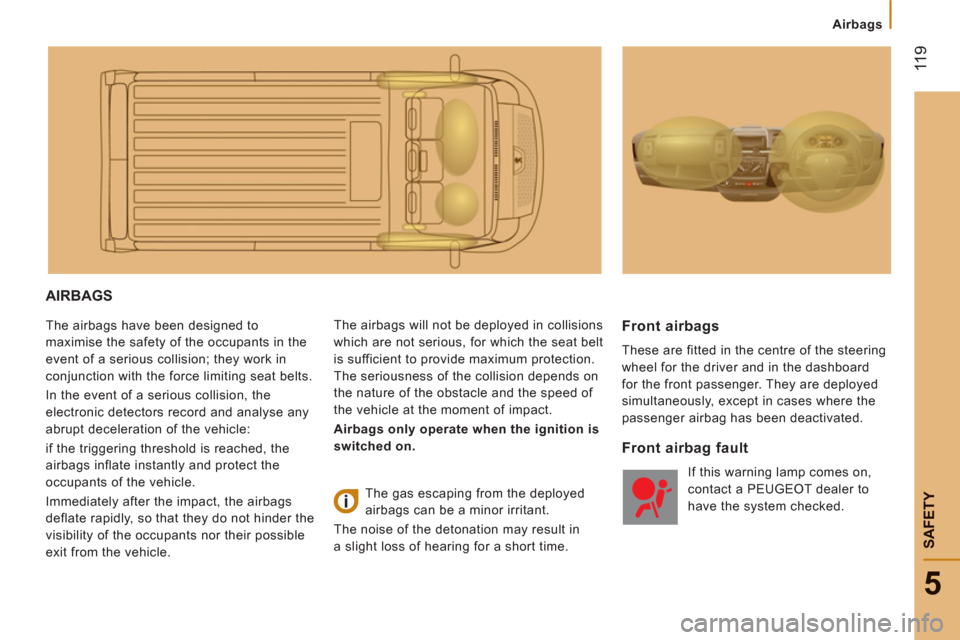
Airbags
11
9
5
SAFETY
AIRBAGS
The airbags have been designed to
maximise the safety of the occupants in the
event of a serious collision; they work in
conjunction with the force limiting seat belts.
In the event of a serious collision, the
electronic detectors record and analyse any
abrupt deceleration of the vehicle:
if the triggering threshold is reached, the
airbags inflate instantly and protect the
occupants of the vehicle.
Immediately after the impact, the airbags
deflate rapidly, so that they do not hinder the
visibility of the occupants nor their possible
exit from the vehicle. The airbags will not be deployed in collisions
which are not serious, for which the seat belt
is sufficient to provide maximum protection.
The seriousness of the collision depends on
the nature of the obstacle and the speed of
the vehicle at the moment of impact.
Airbags
only operate when the ignition is
switched on. Front airbags
These are fitted in the centre of the steering
wheel for the driver and in the dashboard
for the front passenger. They are deployed
simultaneously, except in cases where the
passenger airbag has been deactivated.
The gas escaping from the deployed
airbags can be a minor irritant.
The noise of the detonation may result in
a slight loss of hearing for a short time.
Front airbag fault
If this warning lamp comes on,
contact a PEUGEOT dealer to
have the system checked.
Page 122 of 184
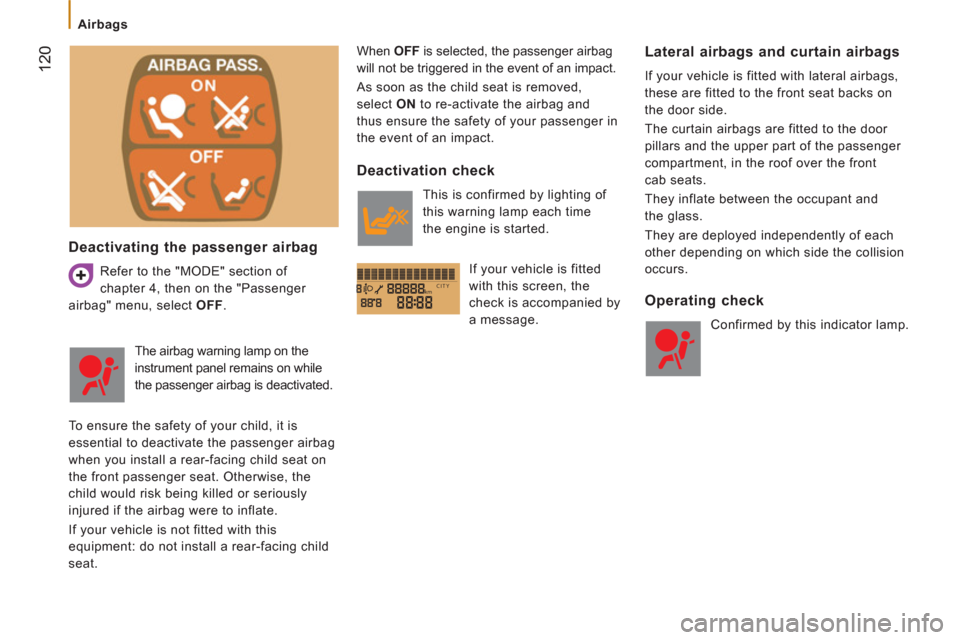
kmCITY
Airbags
12
0
Deactivating the passenger airbag
Refer to the "MODE" section of
chapter 4, then on the "Passenger
airbag" menu, select OFF
. When OFF
is selected, the passenger airbag
will not be triggered in the event of an impact.
As soon as the child seat is removed,
select ON
to re-activate the airbag and
thus ensure the safety of your passenger in
the event of an impact.
Lateral airbags and curtain airbags
If your vehicle is fitted with lateral airbags,
these are fitted to the front seat backs on
the door side.
The curtain airbags are fitted to the door
pillars and the upper part of the passenger
compartment, in the roof over the front
cab seats.
They inflate between the occupant and
the glass.
They are deployed independently of each
other depending on which side the collision
occurs.
The airbag warning lamp on the
instrument panel remains on while
the passenger airbag is deactivated.
To ensure the safety of your child, it is
essential to deactivate the passenger airbag
when you install a rear-facing child seat on
the front passenger seat. Otherwise, the
child would risk being killed or seriously
injured if the airbag were to inflate.
If your vehicle is not fitted with this
equipment: do not install a rear-facing child
seat.
Deactivation check
This is confirmed by lighting of
this warning lamp each time
the engine is started.
If your vehicle is fitted
with this screen, the
check is accompanied by
a message.
Operating check
Confirmed by this indicator lamp.
Page 123 of 184
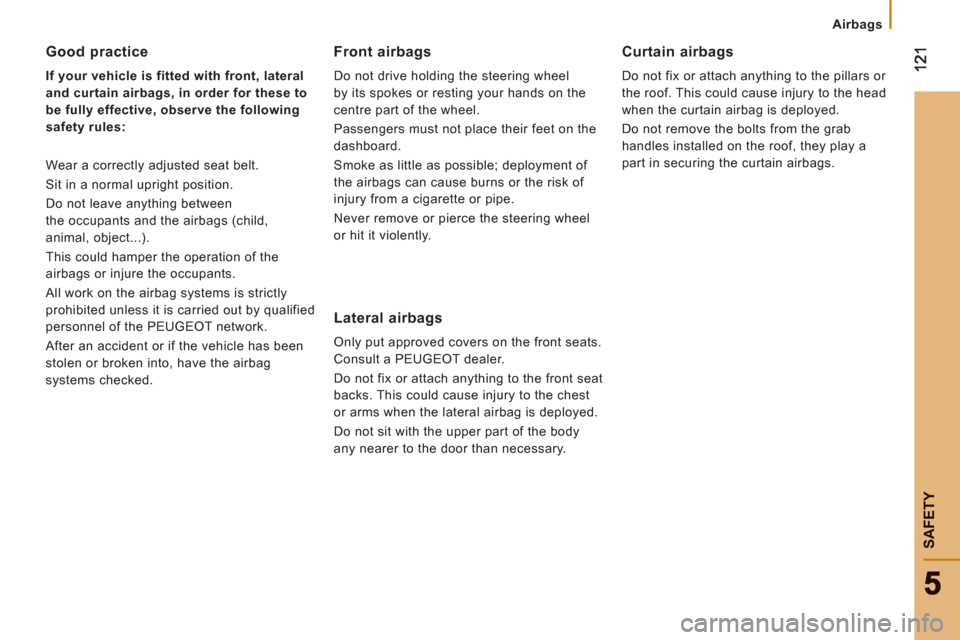
Airbags
SAFETY
Good practice
If your vehicle is fitted with front,
lateral
and curtain
airbags
, in order for these to
be fully effective, observe the following
safety rules:
Wear a correctly adjusted seat belt.
Sit in a normal upright position.
Do not leave anything between
the occupants and the airbags (child,
animal, object...).
This could hamper the operation of the
airbags or injure the occupants.
All work on the airbag systems is strictly
prohibited unless it is carried out by qualified
personnel of the PEUGEOT network.
After an accident or if the vehicle has been
stolen or broken into, have the airbag
systems checked.
Front airbags
Do not drive holding the steering wheel
by its spokes or resting your hands on the
centre part of the wheel.
Passengers must not place their feet on the
dashboard.
Smoke as little as possible; deployment of
the airbags can cause burns or the risk of
injury from a cigarette or pipe.
Never remove or pierce the steering wheel
or hit it violently.
Lateral airbags
Only put approved covers on the front seats.
Consult a PEUGEOT dealer.
Do not fix or attach anything to the front seat
backs. This could cause injury to the chest
or arms when the lateral airbag is deployed.
Do not sit with the upper part of the body
any nearer to the door than necessary.
Curtain airbags
Do not fix or attach anything to the pillars or
the roof. This could cause injury to the head
when the curtain airbag is deployed.
Do not remove the bolts from the grab
handles installed on the roof, they play a
part in securing the curtain airbags. 12
1
121
55
Page 124 of 184
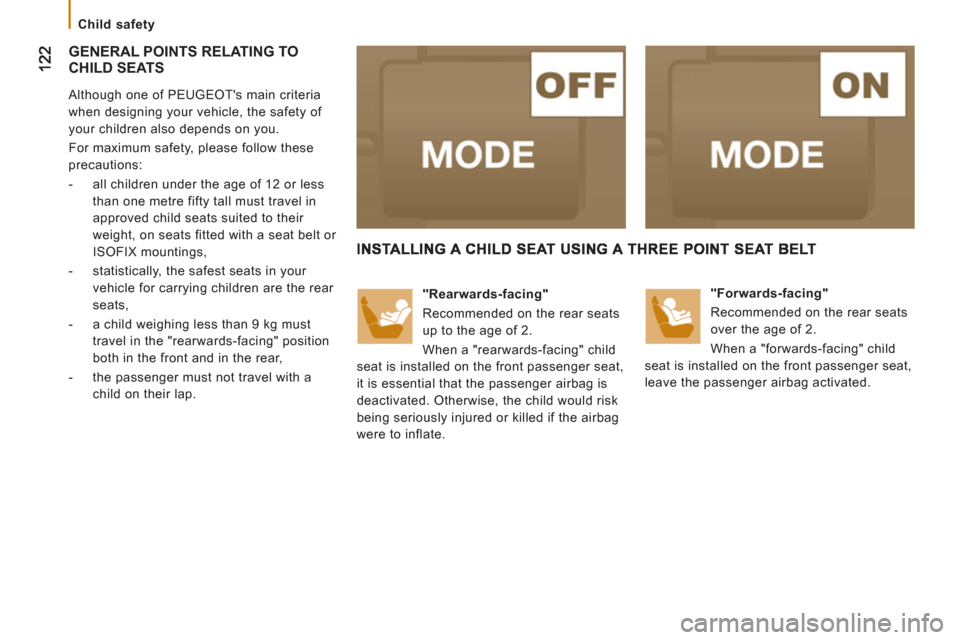
Child safety
GENERAL POINTS RELATING TO
CHILD SEATS
Although one of PEUGEOT's main criteria
when designing your vehicle, the safety of
your children also depends on you.
For maximum safety, please follow these
precautions:
- all children under the age of 12 or less
than one metre fifty tall must travel in
approved child seats suited to their
weight, on seats fitted with a seat belt or
ISOFIX mountings,
- statistically, the safest seats in your
vehicle for carrying children are the rear
seats,
- a child weighing less than 9 kg must
travel in the "rearwards-facing" position
both in the front and in the rear,
- the passenger must not travel with a
child on their lap.
"Rearwards-facing"
Recommended on the rear seats
up to the age of 2.
When a "rearwards-facing" child
seat is installed on the front passenger seat,
it is essential that the passenger airbag is
deactivated. Otherwise, the child would risk
being seriously injured or killed if the airbag
were to inflate.
"Forwards-facing"
Recommended on the rear seats
over the age of 2.
When a "forwards-facing" child
seat is installed on the front passenger seat,
leave the passenger airbag activated.
122
Page 125 of 184
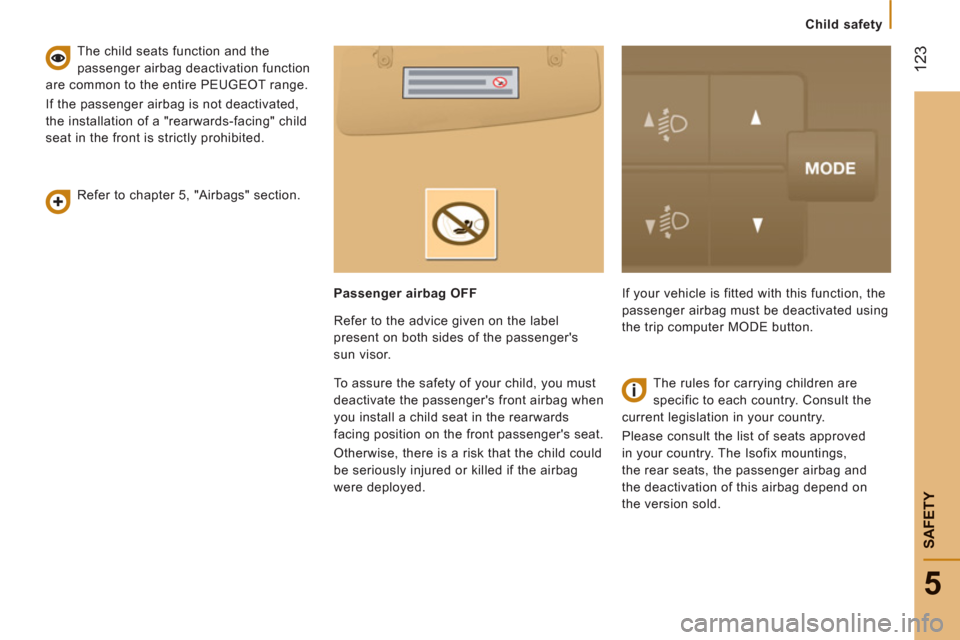
Child safety
12
3
5
SAFETY
Refer to chapter 5, "Airbags" section.
The child seats function and the
passenger airbag deactivation function
are common to the entire PEUGEOT range.
If the passenger airbag is not deactivated,
the installation of a "rearwards-facing" child
seat in the front is strictly prohibited.
If your vehicle is fitted with this function, the
passenger airbag must be deactivated using
the trip computer MODE button.
The rules for carrying children are
specific to each country. Consult the
current legislation in your country.
Please consult the list of seats approved
in your country. The Isofix mountings,
the rear seats, the passenger airbag and
the deactivation of this airbag depend on
the version sold.
Passenger airbag OFF
Refer to the advice given on the label
present on both sides of the passenger's
sun visor.
To assure the safety of your child, you must
deactivate the passenger's front airbag when
you install a child seat in the rearwards
facing position on the front passenger's seat.
Otherwise, there is a risk that the child could
be seriously injured or killed if the airbag
were deployed.
Page 126 of 184
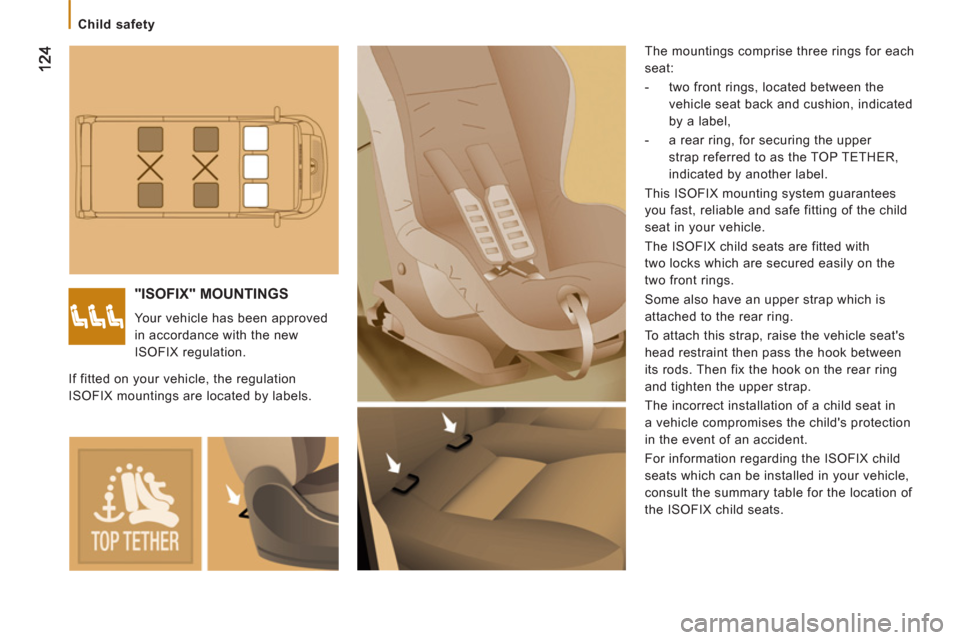
Child safety
"ISOFIX" MOUNTINGS
Your vehicle has been approved
in accordance with the new
ISOFIX regulation. The mountings comprise three rings for each
seat:
- two front rings, located between the
vehicle seat back and cushion, indicated
by a label,
- a rear ring, for securing the upper
strap referred to as the TOP TETHER,
indicated by another label.
This ISOFIX mounting system guarantees
you fast, reliable and safe fitting of the child
seat in your vehicle.
The ISOFIX child seats are fitted with
two locks which are secured easily on the
two front rings.
Some also have an upper strap which is
attached to the rear ring.
To attach this strap, raise the vehicle seat's
head restraint then pass the hook between
its rods. Then fix the hook on the rear ring
and tighten the upper strap.
The incorrect installation of a child seat in
a vehicle compromises the child's protection
in the event of an accident.
For information regarding the ISOFIX child
seats which can be installed in your vehicle,
consult the summary table for the location of
the ISOFIX child seats. If fitted on your vehicle, the regulation
ISOFIX mountings are located by labels.
124124
Page 127 of 184
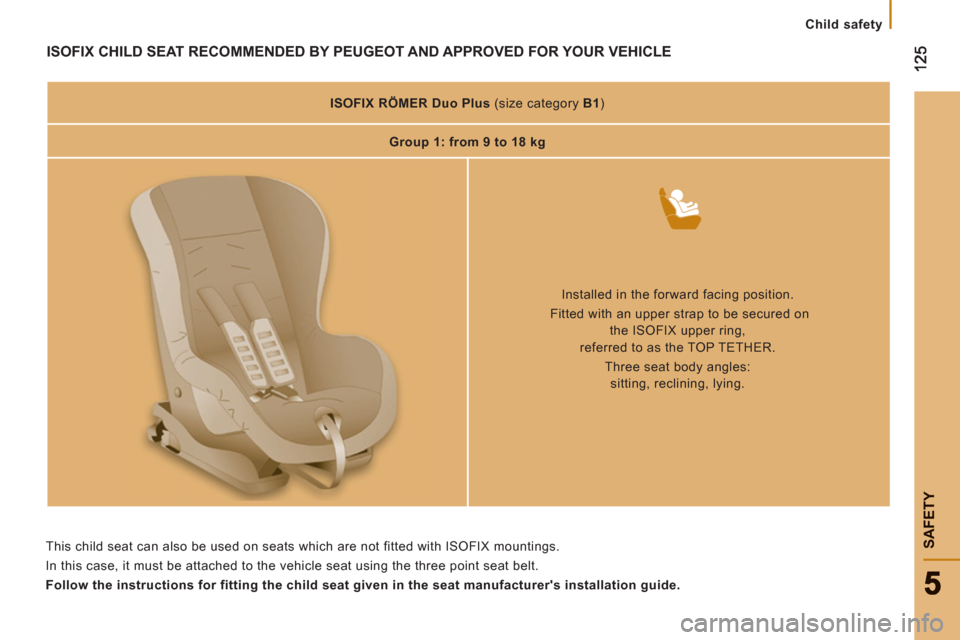
Child safety
SAFETY
ISOFIX CHILD SEAT RECOMMENDED BY PEUGEOT AND APPROVED FOR YOUR VEHICLE
ISOFIX
RÖMER Duo Plus
(size category B1
)
Group 1: from 9 to 18 kg
Installed in the forward facing position.
Fitted with an upper strap to be secured on
the ISOFIX upper ring,
referred to as the TOP TETHER.
Three seat body angles:
sitting, reclining, lying.
This child seat can also be used on seats which are not fitted with ISOFIX mountings.
In this case, it must be attached to the vehicle seat using the three point seat belt.
Follow the instructions for fitting the child seat given in the seat manufacturer's installation guide.
12
5
125
55
Page 128 of 184
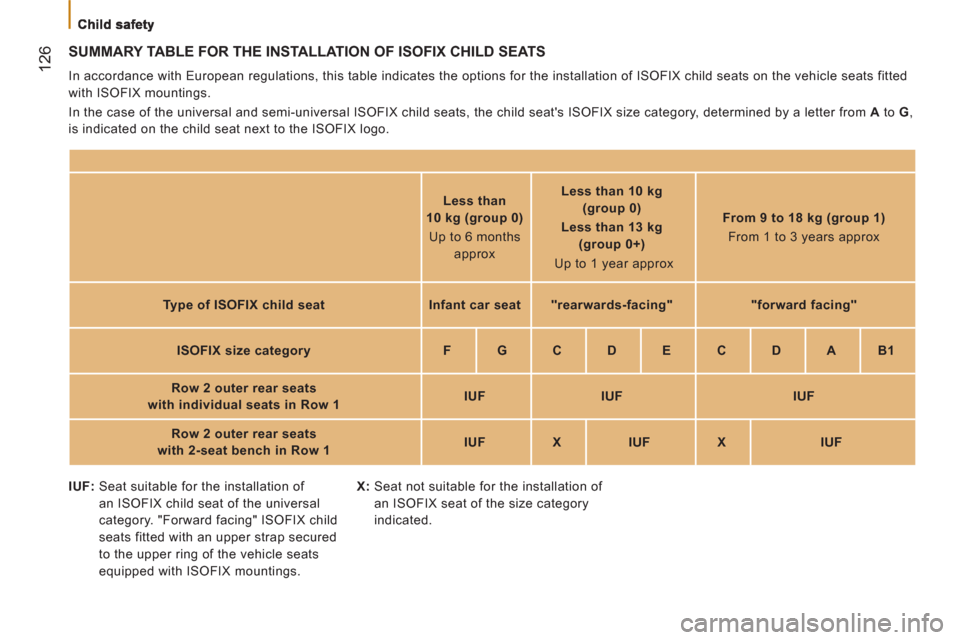
12
6 SUMMARY TABLE FOR THE INSTALLATION OF ISOFIX CHILD SEATS
In accordance with European regulations, this table indicates the options for the installation of ISOFIX child seats on the vehicle seats fitted
with ISOFIX mountings.
In the case of the universal and semi-universal ISOFIX child seats, the child seat's ISOFIX size category, determined by a letter from A
to G
,
is indicated on the child seat next to the ISOFIX logo.
Less than
10 kg (group 0)
Up to 6 months
approx
Less than 10 kg
(group 0)
Less than 13 kg
(group 0+)
Up to 1 year approx
From 9 to 18 kg (group 1)
From 1 to 3 years approx
Type of ISOFIX child seat
Infant car seat
"rearwards-facing"
"forward facing"
ISOFIX size category
F
G
C
D
E
C
D
A
B1
Row 2
outer
rear
seats
with individual seats in Row 1
IUF
IUF
IUF
Row 2
outer
rear
seats
with 2-seat bench in Row 1
IUF
X
IUF
X
IUF
IUF:
Seat suitable for the installation of
an ISOFIX child seat of the universal
category. "Forward facing" ISOFIX child
seats fitted with an upper strap secured
to the upper ring of the vehicle seats
equipped with ISOFIX mountings.
X:
Seat not suitable for the installation of
an ISOFIX seat of the size category
indicated.
Page 129 of 184
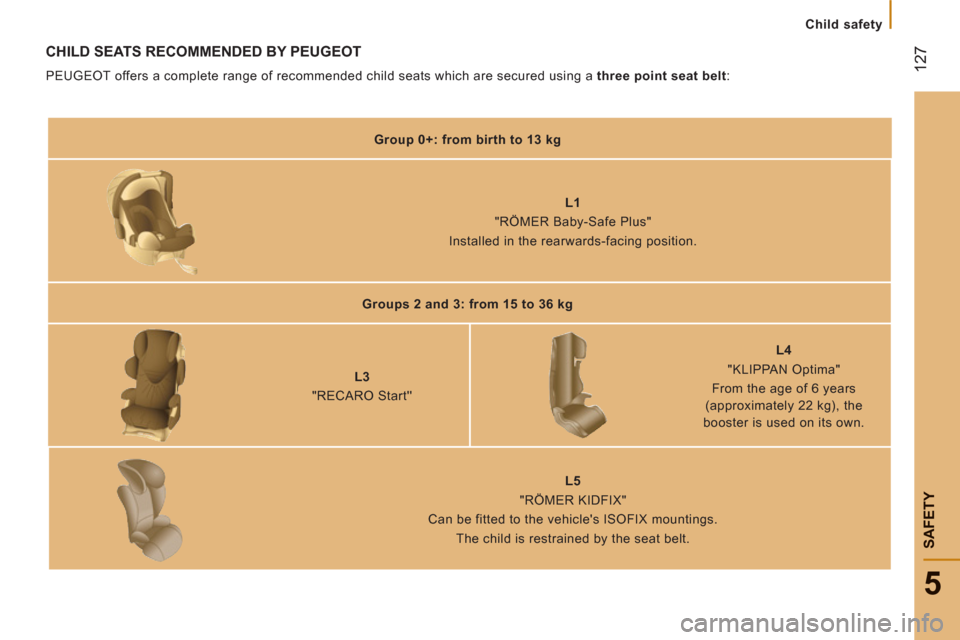
Child safety
12
7
5
SAFETY
CHILD SEATS RECOMMENDED BY PEUGEOT
PEUGEOT offers a complete range of recommended child seats which are secured using a three point seat belt
:
Group 0+: from birth to 13 kg
L1
"RÖMER Baby-Safe Plus"
Installed in the rearwards-facing position.
Groups 2 and 3: from 15 to 36 kg
L3
"RECARO Start''
L4
"KLIPPAN Optima"
From the age of 6 years
(approximately 22 kg), the
booster is used on its own.
L5
"RÖMER KIDFIX"
Can be fitted to the vehicle's ISOFIX mountings.
The child is restrained by the seat belt.
Page 130 of 184
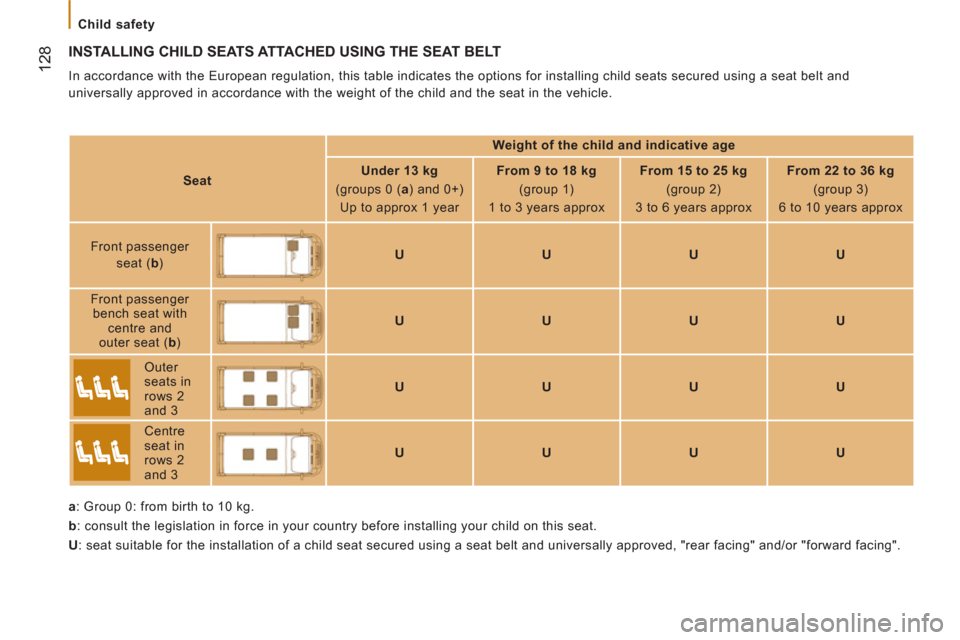
Child safety
12
8
INSTALLING CHILD SEATS ATTACHED USING THE SEAT BELT
In accordance with the European regulation, this table indicates the options for installing child seats secured using a seat belt and
universally approved in accordance with the weight of the child and the seat in the vehicle.
Weight of the child and indicative age
Seat
Under 13 kg
(groups 0 ( a
) and 0+)
Up to approx 1 year
From 9 to 18 kg
(group 1)
1 to 3 years approx
From 15 to 25 kg
(group 2)
3 to 6 years approx
From 22 to 36 kg
(group 3)
6 to 10 years approx
Front passenger
seat ( b
)
U
U
U
U
Front passenger
bench seat with
centre and
outer seat ( b
)
U
U
U
U
Outer
seats in
rows 2
and 3
U
U
U
U
Centre
seat in
rows 2
and 3
U
U
U
U
a
: Group 0: from birth to 10 kg.
b
: consult the legislation in force in your country before installing your child on this seat.
U
: seat suitable for the installation of a child seat secured using a seat belt and universally approved, "rear facing" and/or "forward facing".